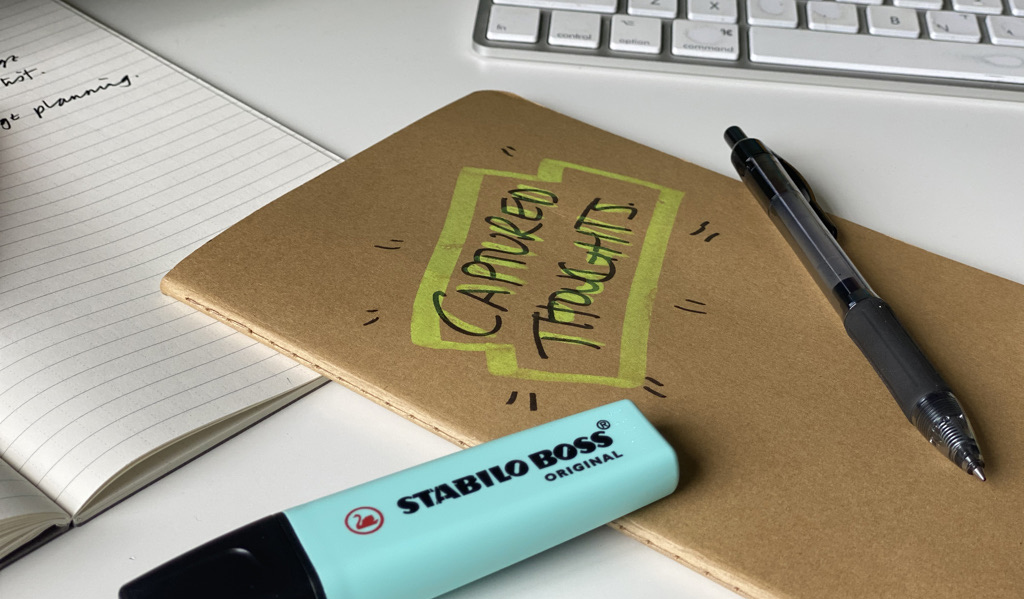A few years ago, I was looking to re-kindle the passion I had once felt for my work. I threw myself into the project of career re-ignition with gusto. Reading, watching Ted talks, listening to podcasts, writing in my journal: the list of information-gathering outlets was exhaustive and I realised I needed an effective way to keep track of the important bits.
One thing I have learned is that how you capture ideas and information is a very personal thing – what worked for me may not be the right solution for you. One universal truth, though, is that simplicity is King, meaning less ways work better. Experiment with different options and build your bespoke toolkit. Here are some methods that work for me:
1. Digital
There are a number of great apps and programs for keeping track of things. Much will depend on how much time you spend on your desktop, phone or tablet, and whether you are an Apple or Android user. (Disclaimer: I am no digital aficionado. This is just my take as a middle-aged Apple user who has found something that works for them.)
- Evernote : I came across this app (which works on both desktop and mobile) thanks to Tim Ferriss, author of The Four Hour Work Week. As a huge information-gatherer himself, it is understandable why he chose this app to make sense of it all. It offers basic note-taking and also has a variety of templates (ranging from meeting notes to project plans). What gives it the upper hand over basic note-taking software is that you can save clips, pages and probably lots of other things direct from the internet. No doubt it offers far more that I am not aware of and never knew I needed.
- Voice Memos : A friend of mine never writes anything down. Everything is noted via “Hey, Siri, open Voice Memo!” and a voice note, recorded on the move. Great if you do not spend much time at your desk or process ideas better through speech than writing. I find voice memos useful for capturing initial ideas, but need to act on the idea quickly or find another way of saving it to make it stick longer term.
- Google Docs : This is a good way to take and store notes from any device. I write all my articles in Google Docs, but prefer something with a more visual aspect to it for note-keeping.

2. Social
Why not use a platform built to share ideas in order to capture your own? Ubiquitous, easy to open and contribute to, social media is an easy way to store your ideas – and you do not necessarily have to share them unless you want to. These are the platforms I use most readily. Twitter, Reddit, or something else could work better for you.
- Pinterest : Great for collating visual stimuli, you can share your boards with the world, choose select invitees or keep your ideas to yourself on a Secret Board.
- Instagram : Put your ideas out there on your grid or save posts that catch your attention to your collection. This sends it to a private selection of your profile that only you can access.
- Facebook : Press the save button next to a Facebook post and it will be organised by category so that you can access it later.
3. Analogue
I personally feel most comfortable with a pen and paper when it comes to taking notes (and I imagine there are a few other mid-lifers out there who would agree). The question is: what paper and what pen works for you?

- Notebook : I have always carried one around with me, but only recently started carrying a book solely devoted to “Captured Thoughts” – no shopping or To Do lists allowed. I heard a writer talking about how she had generated a collection of these notebooks over the years. She delves back into them to retrieve thoughts and ideas otherwise lost in the realms of time. Unfortunately, I listened to the interview before I had started my own CT-Notebook so cannot remember her name.
- Sticky Notes : Whenever I am drafting an article or presentation, I enjoy the flexibility of sticky notes to capture specific points that can be moved around or edited out as the work progresses. I also always use them to stick bright ideas or aides-mémoires to my monitor.
- Highlighter Pen : Amongst past work colleagues, my worship of the humble highlighter pen is legendary. I have a coded colour system to mark notes as “Urgent and Important” or “Important but Not Urgent”. The pages of many of the books on my bookshelves are strewn with stripes of neon, the words beneath to be remembered and drawn upon later.
Finding sure-fire ways to capture information and ideas is key to making changes in your career or lifestyle. There are so many ways and means to do so these days. Settle on a select few that work for you and commit to them. That way, you can curate a library of information to draw on now and for many years to come.


